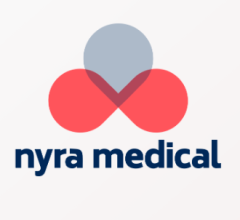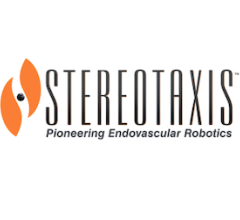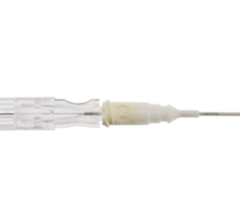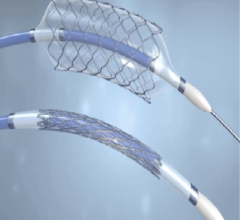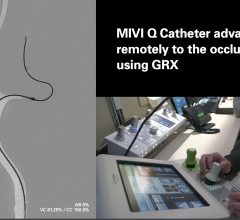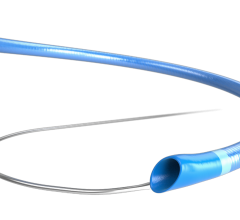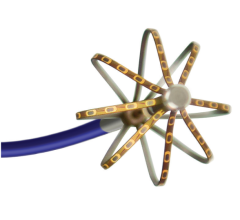
Pepin CEO Brigitte Shaw and philanthropist Tom Pepin, CEO of Pepin Distributing in Tampa, who spearh
It’s not uncommon for a cardiologist at University Community Hospital (UCH) in Tampa to walk about two miles to get his job done — that’s not walking to work, but walking at work. But these doctors — now burning valuable time and energy to find and view images and patient data from one lab and department to another — are about to take a quantum leap into 21st-century efficiency as the hospital prepares to open its new, free-standing, all-digital Pepin Heart Hospital and Patel Research Institute.
With a “soft opening” on Feb. 14 and patient admissions beginning on the 27th, the $50 million, 125,000-square-foot hospital is one of the few fully integrated, paper-light, filmless and wireless healthcare environments in the country in which patient information will flow seamlessly from admission to discharge. Designed and implemented in partnership with GE Healthcare over the course of two years, Pepin is GE’s third all-digital heart center and will be a centerpiece in the Southeast that models a new level of IT sophistication.
“What all-digital truly means is integrating all of your clinical information with all of your legacy systems so you truly have an electronic medical record, you truly have computerized order entry done by the provider, and you have an automated medication administration system,” said Pepin CEO Brigitte Shaw. ”I don’t know of any other facility, quite honestly, that has done this.
“We knew that we could not keep growing our cardiovascular volume in our existing environment,” Shaw continued. “Many hospitals will keep adding space to their different service lines to keep growth happening, but we knew that creating a free-standing facility would be the only way we were going to get some effectiveness and efficiencies. Since we had the opportunity to build brick and mortar, we decided to go ahead and transform the delivery of healthcare, because we truly believe that is where the nation has to go.”
UCH broke ground for the new facility in January 2004, having assessed the needs of the Tampa region, which include high-growth counties and the coming-of-age of a baby-boomer patient population that is both consumer focused and computer savvy.
“Consumers want to be in touch with what is going on with them and with their healthcare,” said C.J. Hosea, administrative director at Pepin. “They are computer oriented and their children and grandchildren are going to be even more so. In an effort to grow and provide the best care, we felt that it was time and this was the place to go in this direction.”
Full Buy-in is Key
Getting everyone on the bus to go in the right direction took special care and coordination. Shaw and Hosea met weekly with cardiologists, cardiothoracic surgeons and other vascular specialists to fully understand their processes in a paper environment in order to incorporate their needs in a paper-light design.
That continuous flow of input was then communicated to and executed with the help of GE project manager Joe Papesch, a resident of the area who was able to partner with Shaw side by side — literally in a next-door office — throughout the two-year project.
Bob Davis, general manager of GE’s Cardiology Sales and Marketing, also met regularly with Shaw via conference calls and frequent on-location visits. He said that once a strategic agreement was signed, a responsive, synchronized and well-rehearsed team of IT and cardiology engineers began revolving in and out of the project site, moving on cue to implement the total enterprise endeavor.
“It’s a massive undertaking, and we’re very proud of the technology and the IT expertise that has gone into Pepin Heart Hospital,” said Davis. “I believe the top reason they chose GE Healthcare was because they could have one partner do all of the pieces, with all of the infrastructure there. The project management and the implementation: that’s really the secret sauce.”
In fact, a few other ingredients were critical to Pepin’s successful design, too.
Re-evaluating all workflows was the hard work, said Shaw, an essential but laborious process that can cause hospitals to fall short of absolute digitalization.
“You cannot automate broken processes,” she said. “If you really want to effectively use information systems to enable your business, you have got to redo your workflows, which then means you’ve got physician and clinician adoption issues. You have to have all the spokes working very closely together to make these kinds of systems work, and that’s why people haven’t done it.”
Clinician buy-in — and the support and cooperation of all hospital personnel — was necessary. And a board of directors whose vision for the hospital to become the leading provider of cardiovascular medicine in the entire Tampa Bay area fueled the process, said Shaw.
“They recognized that we are an amazing community asset, and we wanted to create a program that the community can be proud of,” she said. “We want to get our community involved from a foundation perspective, which has been extremely successful for us because they do see that this is not just another heart program. We’ve made a commitment to our community to research, treat and eventually cure cardiovascular disease.”
When all staff and supplies have transitioned to the new facility over the next few months, Pepin will house a 52-bed pre-post cardiac unit, 16 cardiovascular critical care beds, a 20-bed cardiac surgery recovery unit, 48 progressive care beds, five surgical suites, 10 cardiac cath/invasive procedure labs with additional diagnostic equipment and a dedicated auditorium for education and training presentations. GE is supplying its Cardiac Cath Lab suite of technology, including the Innova 2100, Innova 4100 and Mac-Lab hemodynamic monitoring technology.
Additionally, Pepin installed PatientLine computer devices at every bedside, said Shaw, which patients can utilize for entertainment such as television and movie viewing and Internet access as well as to receive patient education material. Clinicians will use the devices as a means to chart and access patient data without leaving the patient’s side, and to interactively review images, lab and procedure results and treatment paths with the patient.





 October 28, 2025
October 28, 2025 
